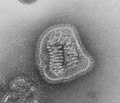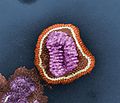Պատկեր:Influenza virus particle 8430 lores.jpg

Նախադիտման չափ՝ 701 × 600 պիքսել։ Այլ թույլտվությաններ: 281 × 240 պիքսել | 561 × 480 պիքսել | 898 × 768 պիքսել | 1197 × 1024 պիքսել | 1663 × 1423 պիքսել.
Սկզբնական նիշք (1663 × 1423 փիքսել, նիշքի չափը՝ 763 ԿԲ, MIME-տեսակը՝ image/jpeg)
Նիշքի պատմություն
Մատնահարեք օրվան/ժամին՝ նիշքի այդ պահին տեսքը դիտելու համար։
| Օր/Ժամ | Մանրապատկեր | Օբյեկտի չափը | Մասնակից | Մեկնաբանություն | |
|---|---|---|---|---|---|
| ընթացիկ | 08:45, 19 Նոյեմբերի 2010 |  | 1663 × 1423 (763 ԿԲ) | Masur | original resolution |
| 19:35, 2 Մայիսի 2006 |  | 700 × 598 (45 ԿԲ) | Patho | {{Information| |Description=PHIL Image 8430 ID#: 8430 Description: This negative-stained transmission electron micrograph (TEM) depicts the ultrastructural details of an influenza virus particle, or “virion”. A member of the taxonomic family Orthomyx |
Նիշքի օգտագործում
Հետևյալ էջը հղվում է այս նիշքին՝
Նիշքի համընդհանուր օգտագործում
Հետևյալ այլ վիքիները օգտագործում են այս նիշքը՝
- Օգտագործումը be.wikipedia.org կայքում
- Օգտագործումը cs.wikipedia.org կայքում
- Օգտագործումը de.wikipedia.org կայքում
- Օգտագործումը de.wikibooks.org կայքում
- Օգտագործումը en.wikipedia.org կայքում
- Օգտագործումը es.wikipedia.org կայքում
- Օգտագործումը et.wikipedia.org կայքում
- Օգտագործումը eu.wikipedia.org կայքում
- Օգտագործումը fa.wikipedia.org կայքում
- Օգտագործումը fr.wikipedia.org կայքում
- Օգտագործումը he.wikipedia.org կայքում
- Օգտագործումը it.wikipedia.org կայքում
- Օգտագործումը ja.wikipedia.org կայքում
- Օգտագործումը lt.wikipedia.org կայքում
- Օգտագործումը ml.wikipedia.org կայքում
- Օգտագործումը nl.wikipedia.org կայքում
- Օգտագործումը ru.wikipedia.org կայքում
- Օգտագործումը sr.wikipedia.org կայքում


